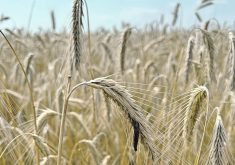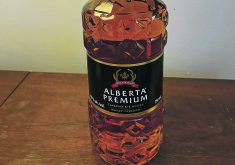The business is not an easy one, but a passion for malting has encouraged a few entrepreneurs to take a leap of faith
This is part of an ongoing series of stories exploring rye, the crop, as it becomes Rye, the whisky.
It’s not something most farmers consider.
But a few are building malting plants on their farms as they work their way into the rapidly expanding world of micro-distilleries and micro-breweries.
Other stories in this series:
- More producers start growing rye as crop prepares for a recovery
- Farmer finds new uses for old crop of rye
- Growing rye for seed is quirky but fun
- Rye’s agricultural journey set over thousands of years
- Hybrid varieties a game changer for rye sector
- Agriculture Canada plant breeder committed to rye
- Rye bread continues to nurture loyal following
- Few remember rye whisky’s Sask. connection
- Rye whisky not as clear cut as tipplers may think
- Art of whisky starts with science of chemistry
- Using rye to make whisky can be a challenge
Read Also

Agriculture ministers agree to AgriStability changes
federal government proposed several months ago to increase the compensation rate from 80 to 90 per cent and double the maximum payment from $3 million to $6 million
“They’re excited to have a local Manitoba craft malt that they can use,” said Jeff Stobbe-Wiebe, who is in the late stages of commissioning a craft malting plant on the family farm at Springstein, Man.
Stobbe-Wiebe isn’t entering the business blind. He worked for eight years as a brewmaster in Winnipeg after being trained at Niagara College in Ontario. He wanted to stay involved in the family farm, but there wasn’t enough straight farm work to employ everybody in the family.
“There’s me, my dad and my brother, so we needed to find some outside work, and for me it lines up perfectly to malt,” said Stobbe-Wiebe.
“With my background of farming and brewing, if you cut it down the middle, it’s malting.”
Malting is the process of beginning germination and then shutting it down, which produces enzymes useful in baking and fermenting.
Not all or most “rye” whiskies contain malted rye. Many use the basic unmalted grain, and add enzymes and other substances to produce their foundational liquids. But having some malted rye allows for more of the enzymes to come from the rye itself, and it can allow for higher levels of rye grain in the base of whiskies.
Stobbe-Wiebe’s idea isn’t new. In fact, the commercial-grade equipment he’s installing in his new malting facility west of Winnipeg, which can process four tonnes of grain per week, comes from the Red Shed Malting outfit in central Alberta, another family farm venture.
“Jeff’s going to knock it out of the ballpark,” Matt Hamill, manager of malting on his family’s fourth-generation farm and artisanal malting operation, said about Stobbe-Wiebe’s venture.
He knows a bit about it. The equipment Stobbe-Wiebe is installing now is the gear Red Shed has grown out of. Red Shed expanded this year, growing with the blooming of Alberta’s craft brewing and distilling community, and it needed a new line of bigger malting equipment. Stobbe-Wiebe picked up Red Shed’s former equipment and is about ready to go into full production. There’s just the matter of completing electrical and permit work.
Life hasn’t been easy for these pioneers. Hamill acknowledged that jumping into craft malting when there were only 20 independent alcohol-makers in Alberta was a leap of faith.
“It’s been a slog. It was a slow start and a slow growth of sales. But it’s been consistent growth,” said Hamill.
“It was really hard to find equipment, to find anybody to build the equipment.”
But with the boom in Alberta craft booze-making, Red Shed has scaled up. From only a couple of dozen brewers and distillers a few years ago, the province is now home to more than 150, with more in the wings, either in construction or waiting for their first barrels of whisky to become legal whisky. (Canadian whisky must spend at least three years in the barrel before it achieves its true name.)
Rye isn’t easy to work with, most distillers say. Not only is it a cantankerous grain, with much stubborn fibre and prideful toughness — a virtue to farmers looking for resilient winter crops able to handle western Canadian winters — but it comes in various qualities, consistencies and varieties. It’s not a bulk commodity crop grown in millions of tonnes everywhere. Few grow rye, and what the few who grow it are sowing varies widely, as do the soils in which they grow it.
That’s another challenge for the micro-maltster.
Becoming a prairie micro-maltster is a strange path to take.
But for these entrepreneurs, founding a leap-of-faith operation on the family farm to serve a tiny, growing market enrols them in a tiny, but warm and welcoming fraternity of co-creators.
“The malting community is pretty small,” said Stobbe-Wiebe.
The other west-of-Winnipeg craft maltster, Dacotah Malt, is in the same local community and blazed the trail for Manitoba craft malting, evolving the farm operated by Rauri Qually and Pam Bailey into an ag business.
“The craft malting industry, everybody wants to make sure all Canadian malt is good, so when people hear the term Canadian malt, it’s a good thing.”
While Red Shed has been providing malted rye to distillers for years, Stobbe-Wiebe intends to be cautious with his steps into “fun” malts. Basic barley for beer first. Fancy beer second. Other liquor third.
“The fun beers are your hazy IPAs, your bourbon-barrelled stouts, but what pays the bills are your pale ales or your pilsners, and that’s going to be the same thing as the malt house,” said Stobbe-Wiebe.
“It’s barley, it’s base malt we’ve got to start with. Once we have that under our belt, then we can start venturing out and doing some of the more fun things: rye, wheat, oats.”
Rye whisky has always been the source of fun, but when it comes to distilling, it went into a long dark night of disregard in Canada, its spiritual home.
As this series of stories has discovered, rye whisky has begun a rebound in whisky favour and fashion, and Hamill is keen to be a part of it.
“Rye’s coming back,” he said.
“Bourbon had its moment. Now it’s rye’s time to shine.”


















